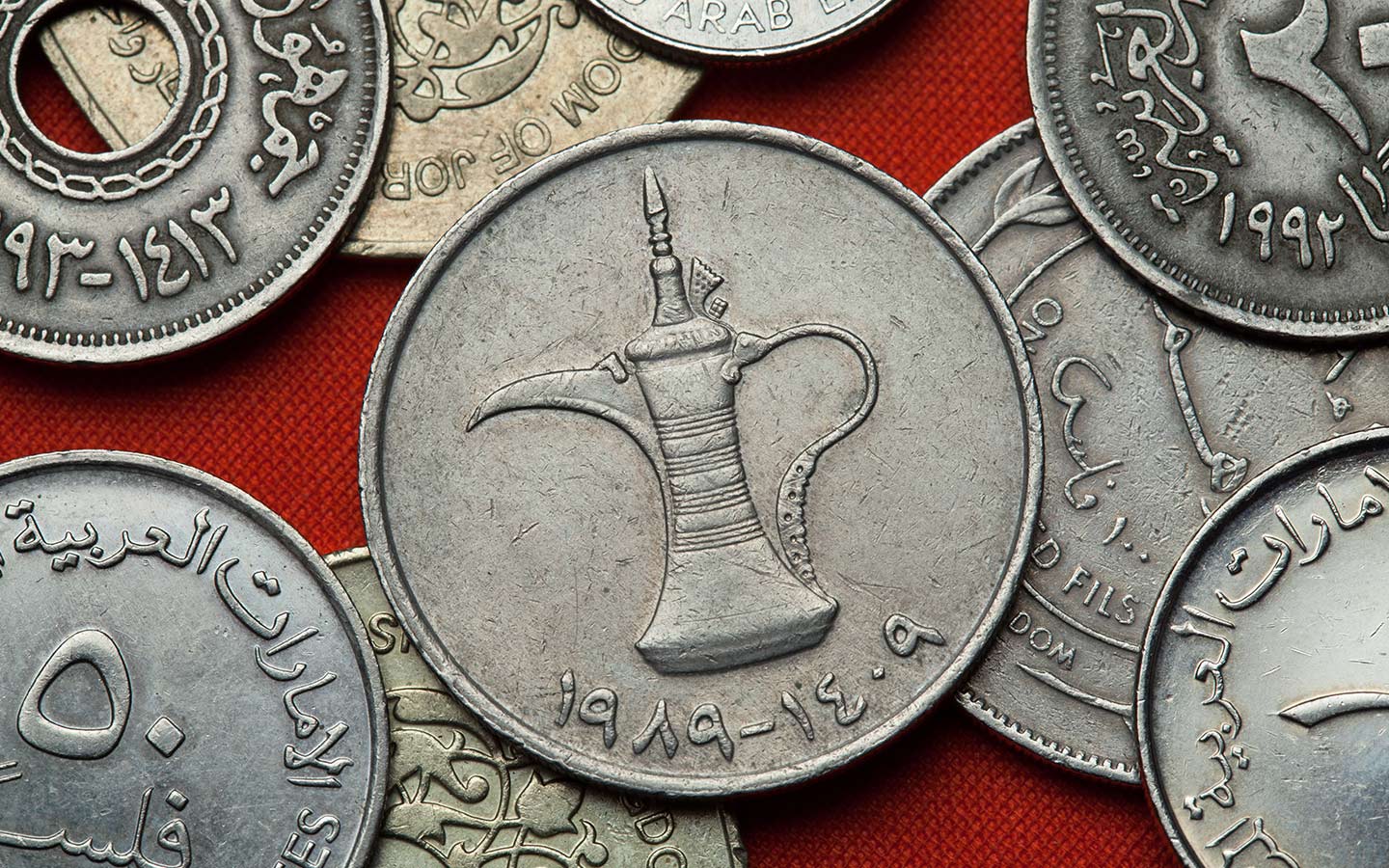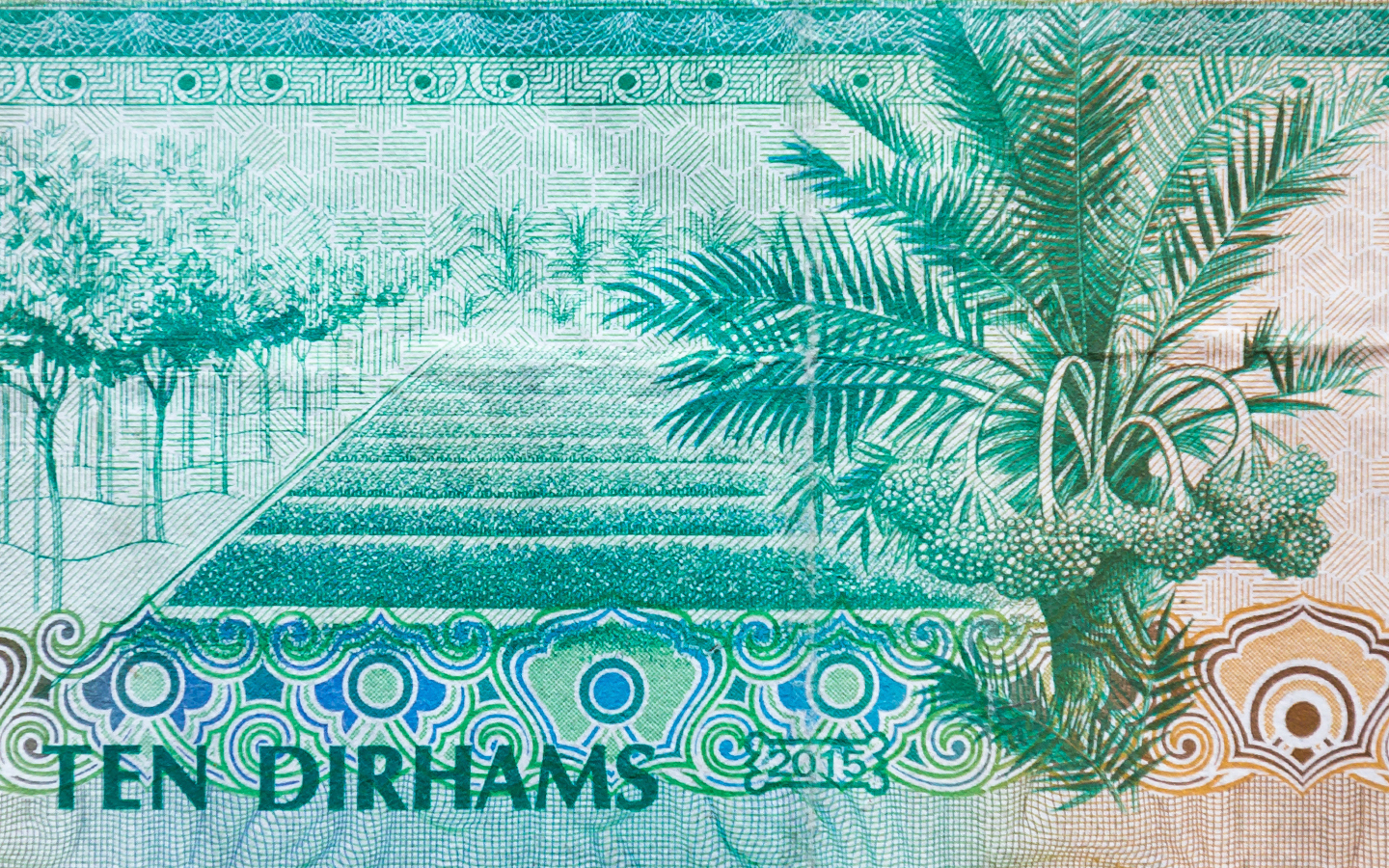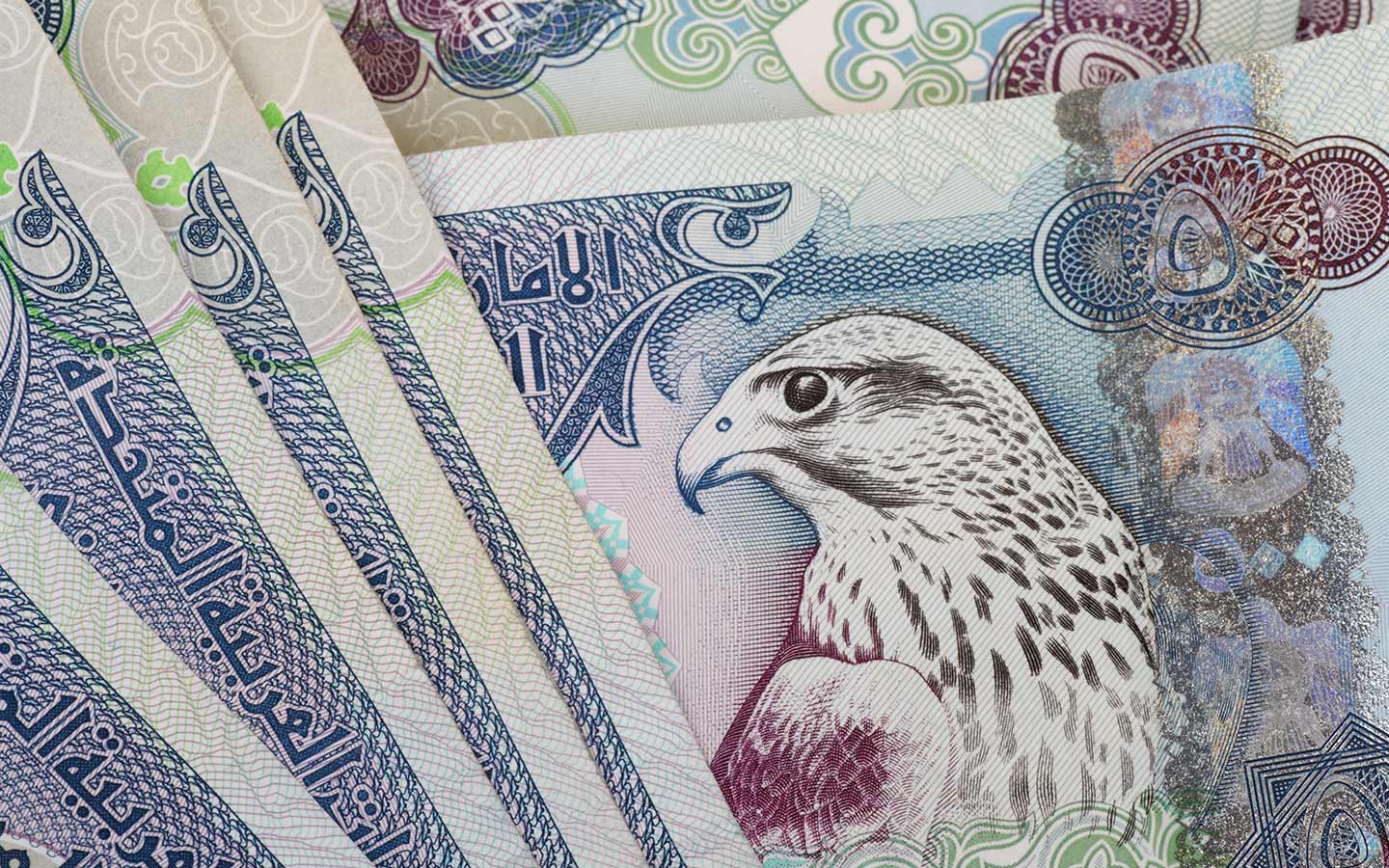Do you ever stop and notice the various objects that appear on your UAE dirham coins and notes? While they may seem a bit abstract in nature, a lot of these symbols are representative of the UAE’s heritage and reflect the country’s progression from a fishing town to the multi-cultural metropolis it is known as today. Let’s take a look at some of these UAE currency symbols and by the end of it, we’re pretty sure you’ll learn a thing or two about the rich culture and heritage of this vibrant country.
What is the UAE Currency name?
The currency of the UAE is the Dirham and is denoted by coins and banknotes, of which many feature the national symbols of the UAE. The UAE currency is abbreviated by AED, Dh or Dhs. As for the dirham sign in Arabic, it is represented as د.إ
What are the symbols on the UAE coins?
The coins in the UAE come in three denominations – the 1 Dirham coin, 50 fils coin and the 25 fils coin. The obverse (front) of these coins each has a unique symbol and the year of mint below in both the Hijri and Gregorian year. You can even find several commemorative coins which are minted specifically to feature rulers of the UAE and other designs to celebrate landmark events. As for the reverse (back) of the UAE coins, they feature the lettering ‘United Arab Emirates’ in both English and Arabic along with the denomination of the coin. All numbers on the UAE coins are represented in Arabic characters.
Here is a closer look at each of the unique symbols on the UAE coins and what they represent.
1. Dallah Coffee Pot on the 1 Dirham symbol

Representing the core of Emirati culture and hospitality for guests, the Dallah coffee pot appears on the most commonly-used denomination of the UAE currency – AED 1 coins. The age-old tradition of welcoming guests with a steaming pot of Arabic coffee and dates is practised among Emirati families till today. Arabic coffee (called Qahwa) is usually a delicious blend of cardamom and saffron served in tiny cups.
2. Oil Derricks on the 50 fills currency of UAE

And then, there was oil! The little structures you see on 50 Fils coins are actually three oil derricks marking the turning point in the UAE’s history. Contributing massively to the country’s progress, oil was first discovered in the 1950s, even before the seven emirates had united to form the UAE. Before the discovery of oil, fishing and pearl-diving were the main sources of income in the UAE. The first export took place in 1962 from Abu Dhabi, and the rest, as they say, is history.
3. A Gazelle on the 25 fills currency of UAE

Animals are a popular UAE currency symbol feature for both coins and Dirham notes. The animal you see on the tiny 25 Fils coins is the Arabian Sand Gazelle, a native of the UAE’s desserts. These magnificent creatures are mostly found in the deserts of Abu Dhabi. They are an integral part of wildlife in the UAE and are known to have been around since the time of the late Sheikh Zayed bin Sultan Al Nahyan.
What are the UAE currency symbols on the banknotes?
The bank notes of the UAE currency can be found in denominations of 5, 10, 20, 50, 100, 200, 500 and 1000. Both the obverse and reverse of the dirham notes showcases a UAE currency symbol unique to it. Here is a look at the symbols on the bank notes of the UAE currency.
4. Blue Souk in Sharjah – 5 dirham note

If you are a resident of Sharjah you know this place very well. Built-in 1978 the Blue Souk in Sharjah, also known as the Central Market is a major hub for trade and shopping in the emirate. Its vibrant atmosphere and rich history make it one of the best places to visit in Sharjah. You can find over 600 shops selling everything from gold to electronics here. This traditional bazaar spans an area of 80,000 sq. m. and is built with the most stunning architecture making it one of the biggest historical landmarks in the UAE and a fitting symbol for the UAE currency.
The UAE currency symbol on the reverse of the AED 5 banknote is of the Imam Salem Al Mutawa Mosque, formerly known as Al Jamaa mosque in Sharjah – another major landmark of the emirate
5. Omani Dagger – 10 Dirham symbol

You may remember seeing these traditional daggers sold in souvenir shops around the UAE. The Omani dagger, or khanjar in Arabic, was traditionally carried by men who used the weapon for hunting and protection. The object continues to be of a cultural significance today, symbolizing security and power prevalent in the UAE. Today you’ll find these daggers at several souqs around the country in beautifully-adorned cases. While the need to carry them around may have diminished, these distinguished cultural objects make great collector’s items and remain an iconic symbol of the UAE’s heritage and cultural past.
6. Palm Tree – 10 dirham symbol

The one thing that was always around in the UAE is, of course, the palm tree. This one is a UAE national symbol that we most strongly associate with life in the Middle East. The palm tree was a source of food and shelter before the country transformed into the modern, commercial hub that we know. Symbolizing sustenance and hospitality, the palm tree appears on the AED 10 currency note as a reminder of what stood tall in the country before the era of the skyscrapers and shopping malls.
7. Dhow Sailing Boat – AED 20 Dirham Note
The iconic dhow boat appears on the AED 20 currency note. Early day Emiratis relied almost solely on fishing and pearl diving for their income. These traditional sailing vessels with their distinct lateen sails would take divers and fishermen out to sea for months at a time. Sailing and freediving were dominant occupations among most local men. Like a lot of the national symbols, this one also serves as a reminder of the pre-oil era in the UAE, when men needed to rely on dhow boats to make ends meet.
8. Arabian Oryx – 50 dirham banknote

You may remember seeing this distinct antelope on your AED 50 currency notes. This regal creature is a desert native and also the UAE’s national animal. Its population was marked as extinct back in the 1970s but thanks to conservation efforts mainly by His Highness Sheikh Zayed Bin Sultan Al Nahyan, the Oryx survives and roams the land with pride. While it does not have a cultural or economic significance in UAE traditions, the Arabian Oryx is a testament to the country’s constant dedication towards preserving its native wildlife.
9. Al Fahidi Fort – AED 100 note in the UAE

The next UAE currency symbol we are going to talk about is the one on the 100 dirham note – the Al Fahidi Fort. This place acted as the residence of the rulers and a fort of defence for the country over 200 years ago. Built in 1787, this is one of the most important landmarks that represent the UAE heritage. The fort still stands in the Al Fahidi area in Bur Dubai as the Dubai Museum now, where visitors can catch a glimpse of the historical artefacts as well as get an insight on the life of people in the UAE back in the day. The UAE Coat of Arms can also be seen on the 100 dirham banknote.
10. The Central Bank of the UAE Building – AED 200 note

The Central Bank of the United Arab Emirates is the entity that is responsible for managing the currency of country making it a fitting symbol on the UAE currency. This iconic building is located at the Al Fahidi District, facing the Dubai Creek.
11. The Falcon – 500 dirham note

You may already know the importance of these majestic birds and their central role in Emirati culture, resulting in the much-loved tradition of falconry today. Bedouins first used these birds to hunt small prey native to the desert and managed to train falcons to deliver it while it’s still alive. This survival tactic gradually evolved into what is a favourite pastime amongst locals and a fascinating cultural aspect for tourists today. A regular on UAE currency notes, the falcon is also the national bird of the UAE and sits proudly as the official emblem of the country.
12. The Qasr al-Hosn – AED 1000 dirham note

The largest denomination of banknotes in the UAE is the 1000 dirham note and on this note, you can see the Qasr Al Hosn, the oldest stone watchtower in Abu Dhabi. This watchtower that was built in the 1790s to safeguard the island, acted as the former seat of the Abu Dhabi government and was home to the ruling family. In late 2018, the Qasr Al Hosn was reopened as a museum, hosting many historic relics and artefacts.
The Central Bank of The United Arab Emirates (CBUAE) decided to honour the founding fathers of the nation by issuing seven commemorative silver coins to celebrate the 50th UAE National Day. These coins are available for purchase.
So there you have it – a glimpse into the rich and fascinating UAE heritage through the national symbols that we see on its currency. Don’t let the skyscrapers fool you, there is so much more to this country than what meets the eye. Lying just below the dazzling shopping malls and vertigo-inducing towers, the UAE has its own cultural identity that it has managed to proudly retain over the many years of change and progress.
Want to know more about the UAE? Check out these heritage sites in Dubai for something old and our roundup of the UAE’s tallest buildings for a taste of something new!





This page was really helpful
Thank you for your kind feedback Maimouna!